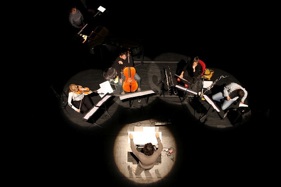|
|
>> Versão Portuguesa |
| New Art of Sound MANUEL PEDRO FERREIRA |
2012.06.04 |
|
Perhaps the first performed work belongs, nevertheless, to a different league, in which profusion replaces construction to a great extent. “Die Lebensfreude” (commissioned by the Miso Music), by Brazilian composer Eduardo Reck Miranda, attaches sound fragments, with the firmness of push pins, to a thin guiding thread, which is conveyed principally by the piano; in the 2nd movement, this thread attaches itself, capriciously, to a homelike evocation of the Bossa Nova. The visual projections accompanying the music distract, if not repel, within a spirit, which seems to be more naïve than light, and which risks of undergoing the pretentious. On the other hand the other composers represented, let themselves transpire, in spite of the variety of proposals, a recent tradition of great aesthetic demand and technical sophistication; it is perhaps significant that three of them graduated from the same institution, the High Music College in Lisbon (Escola Superior de Música de Lisboa). “Pensamentos perdidos” (2012) Ana Seara (composed for the Sond’Ar-te) is an electro-acoustic work of enormous density and richness, in which all of the elements and layers, although disparate, emerge perfectly integrated in the sound flux in constant transformation, in which one also finds a moment replete with lyricism. A compact work, surprisingly mature, which certainly calls for repeated auditions. “Intensités” by Ricardo Ribeiro, in a version for clarinet and live electronics (2008 or 2009), was the only work that had been premiered before. It was worth listening to the monodic line, strongly structured in an atonal language of traditional writing, expressing its anxiety with the respective sound aura, parasitically full of events. The composer, well understood by the clarinettist Nuno Pinto, succeeded in being passionate and precise in his discourse. The works of António Chagas Rosa and Bruno Gabirro both commissioned by Sond-Ar-te, followed Ricardo Ribeiro’s piece. “Música de cena para Santo Antão” (2012), by Chagas Rosa, is a piece of purely acoustic nature, which gives continuity to a strongly personal style, full of dramaturgy. It is structured in three movements, reserving (in a baroque manner) the slow tempo for the second one, and the major vivacity for the last. Nevertheless the piece’s relative proportions do not seem to me completely tuned. The first movement is characterised by a rhetoric of great gestures whose fluency and contrast at the the dynamic and timbric levels seemed to ask more for an orchestra than a small chamber ensemble. Even so, it is noteworthy what can be suggested; the effect of insistency and the confluence on metrical regularity being a cause of redundancy, the prolongation of the auditory experience diminishes the aesthetic impact. The second pleasantly meditative movement afterwards, appears to us as being too short. Only in the last movement, in which the syncopated pianistic blocks of a vaguely jazzy character are united to the saturated piercing sounds, did there seem to exist a complete coherence between proportion and content. The last work, with an uncommonly long title, “but I have many friends and some of them are with me” (2012), was a surprise. In it, Bruno Gabirro offers us an admirable discourse through both the audacity and the elegance of the formal construction. This audacity is manifested, in the first place, in the continuity between the noise and traditionally “musical” sonority: this idea is not new, but the form in which various types of blowing (from the background or breathed) occur and converge, or the form in which musical intentionality is conferred to the turning of the pages, cancels that distinction, in a more radical way than usual. The audacity is also expressed in the continuity between sound and silence: once more, although this is also quite an old idea, its minimalist exploration reveals itself as exceptionally courageous. The selection of harmonic material surpasses the usual stylistic oppositions, and the use of the instruments is quite free from convention. Then, the piece’s form, which is constructed little by little, affirms itself with its own coherence. That is why, when the main body of the piece comes to an end, one does not doubt that that is precisely what happened. The inclusion of a piano coda, for which one waits interminably after such ending, is perhaps the only artistic decision whose need is not evident for the listener. What remains now is to draw attention to the professionalism of the Sond’Ar-te Electric Ensemble demonstrated during this concert. Ana Raquel Lima (flute), Nuno Pinto (clarinet), Elsa Silva (piano), Suzanna Lidegran (violin) and Filipe Quaresma (violoncello) performed under the firm direction of Guillaume Bourgogne, with the technical assistance of José Grossinho, who counted with some extra help from other collaborators. |
|
 A concert of the
A concert of the